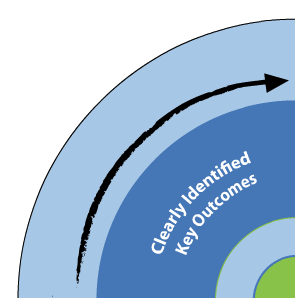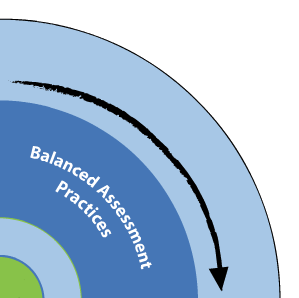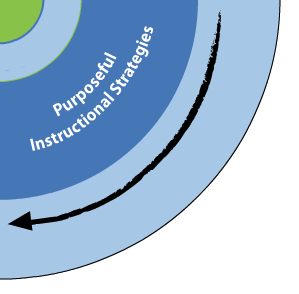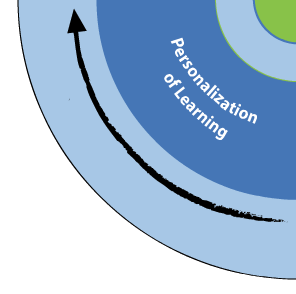Text Structure
Page Navigation
(Click to jump to section)
| Brief Explanation | Research | Characteristics of a Skilled Reader | Clearly Identified Key Outcomes | Balanced Assessment Practices | Purposeful Instructional Strategies | Personalization of Learning |
Brief Explanation
Text structure refers to how the information within a written text is organized. It acts as a road map for reading comprehension. When students understand the structure of the text, they know how ideas are arranged and know what to expect from the text. This knowledge then aids students in understanding the relationships of information within the passage. Making these connections is vital in comprehension and learning from information presented in the text.
Research
- Effective readers are aware of the structures of texts, and they can use this information to help them anticipate, monitor, and comprehend what they are reading (Taylor & Beach, 1984).
- If students understand and can identify text structures, they will be more likely to understand, remember, and apply the ideas they encounter in their reading (Weaver & Kintsch, 1991).
Characteristics of a Skilled Reader
With
Increasing
Sophistication
- Understand a variety of text features in a variety of genres.
- Can preview text (highlight titles, headings, and subheadings and tell what the text might be about).
- Can compare and contrast information on two topics by finding similarities and differences.
- Can identify cause and effect statements in text.
- Know how and where to find the answers to teacher-generated questions (especially those that require inferencing and using prior knowledge).

Clearly Identified Key Outcomes
Use your programs of study for curriculum outcomes related to text structure.
Please refer to CESD’s Essential Outcomes work if you are using the previous Alberta Curriculum (Grade 7+).
Here is the New Alberta ELAL Curriculum, from the New Learn Alberta website, laid out like a scope and sequence.

Balanced Assessment Practices
- The ability to transfer knowledge of text structure into writing
- Teacher observation – during reading and writing activities and conferences
- Student is able to describe the components and structures of a variety of genres
- Student responses and work samples
- Evidence that students are able to articulate text features and structures during reading
- Students demonstrate understanding of sequencing of events, main ideas, paragraph formats, etc. – for example: using graphic organizers, retelling stories, highlighting main ideas, summarizing, writing paragraphs on a given topic, etc.


Purposeful Instructional Strategies
PRE
- Students should be exposed to a variety of texts.
- Teaching components/structure of a story
- Lots of exposure to narrative text – purposeful instruction while reading to students about the above components of narrative texts
- Exposure to a wide variety of expository texts
- Instruction related to components of expository text such as headings, fonts, sections, etc.
- Experience with writing and producing expository text, when applicable
- Vocabulary taught ahead of reading the text
- Understanding of the key features of expository text – compare/contrast, cause/effect, description, sequencing
- Have students preview the text by surveying the title, any headings, illustrations, and structure to determine if it is relevant to their purpose and to identify those sections that might be particularly pertinent (Reithaug, 2002, p. 171)
- Use read-alouds to teach students about how information is organized in expository text. This may make it easier for students to figure out where information is found. If they are confused while reading, they can think about how the text is organized and see if there is something in the arrangement that will help them to understand what they are reading. Gaining familiarity with these common structures, therefore, could enhance students’ comprehension. These structures include: (Reithaug, 2007, p.176)
- Teach signal words in non-fiction texts (Reithaug, 2007, p. 176)
- Use examples from background knowledge and prior life experience to demonstrate structures of expository text for students – for example, describe a problem you have experienced in your own life and how it was solved (to introduce problem-solution); describe a situation where a choice you made caused something to happen (to introduce cause-effect)
DURING
- Independent reading strategies could include a reading response journal, drawing the story in a story board while reading, post-it notes for new vocabulary, etc.
- Use graphic organizers to help students recognize the different organizational structures of texts across subject areas and to enable them to collect, interpret, and remember information (e.g. Timelines for sequencing events in history, cause and effect charts to explain relationships in science, story frames to remember what happened in a story, etc.) (Reithaug, 2007, p. 175)
- Story maps
- Cues and strategies provided as students are reading the text
- Chunking the content of the text and checking for understanding as students are reading
- Mind-mapping, note taking, highlighting, graphic organizers, Venn diagrams, etc. to aid in comprehension as students are reading
- Pointing out and highlighting structures and characteristics of expository text as reading
POST
- Reflecting on reading to check comprehension – engaging in purposeful conversations with students about what they have read, and how they have used text structure and features to enhance their comprehension – providing students with many varied opportunities to discuss and debrief about what they have read (teacher conversations and conferences, peer conversations and conferences, etc)
- Reflective questioning
- Creative responses to the text
- Retelling
- Reflection and connection with what was read – how does the content of the text connect with prior knowledge, scaffold on previous learning, etc.
- Strategies for checking understanding – questions about the text, cloze activities, quizzes, extension activities, creative responses to the text
- Go back and reread key sections as required to ensure understanding
RESOURCES TO SUPPORT OVERALL DEVELOPMENT
- Empowering Writers by Barbara Mariconda
- Six Traits of Writing
- Betty Wiebe
- Dawn Reithaug Books
- The Writing Rope by Joan Sedita





Personalization of Learning
- Understanding individual students’ reading abilities, strengths and weaknesses is key to personalization
- Students with limited experience with expository text will require specific teaching around the unique features of expository texts.
Other Resources and Support
Banks of letter manipulatives Michelle created for use in Google Slides
Banks of Dolch sight word manipulatives Michelle created for use in Google Slides